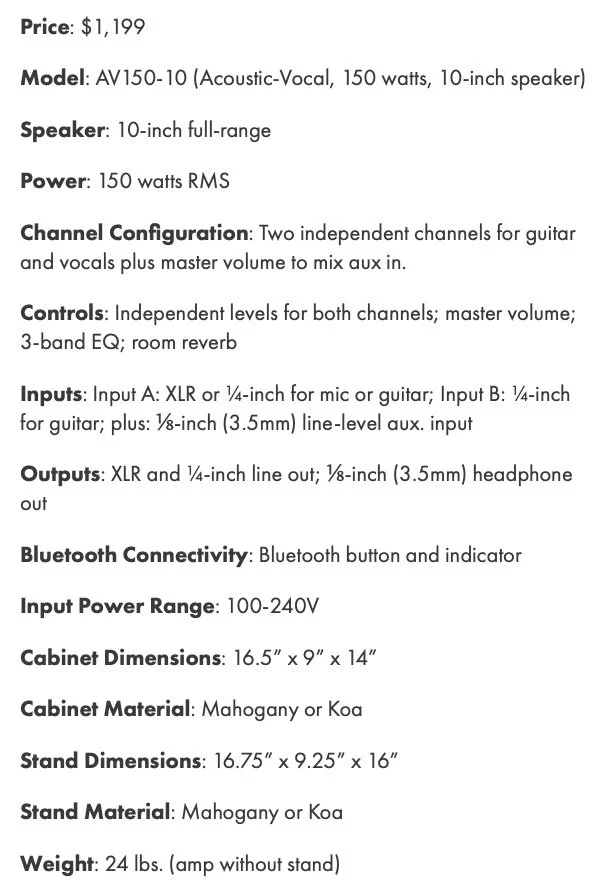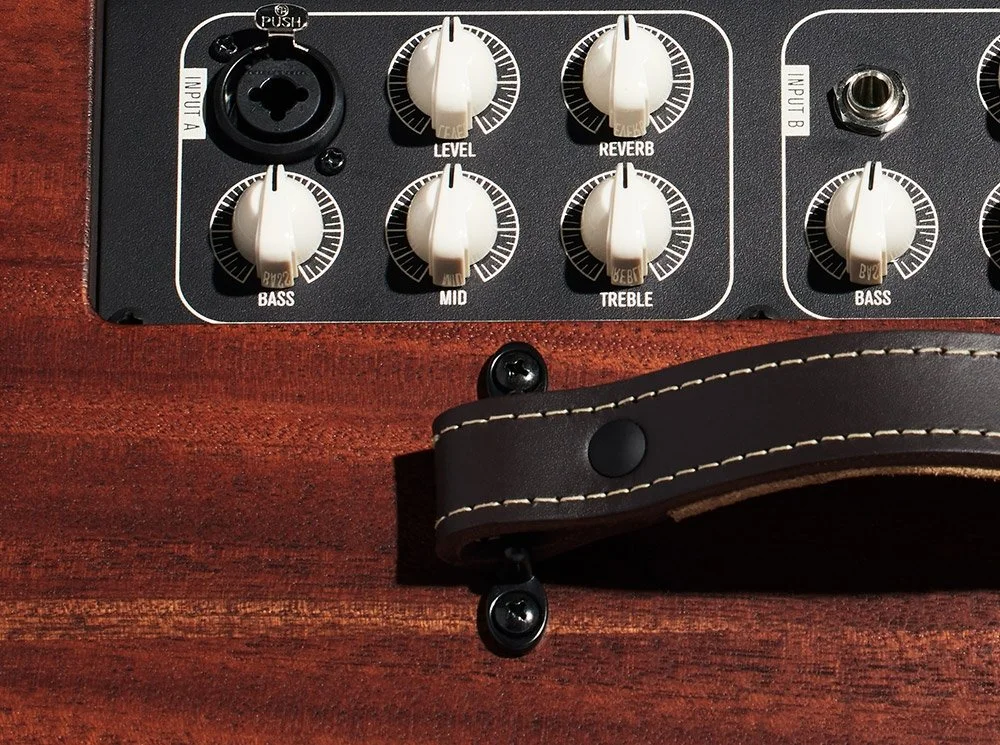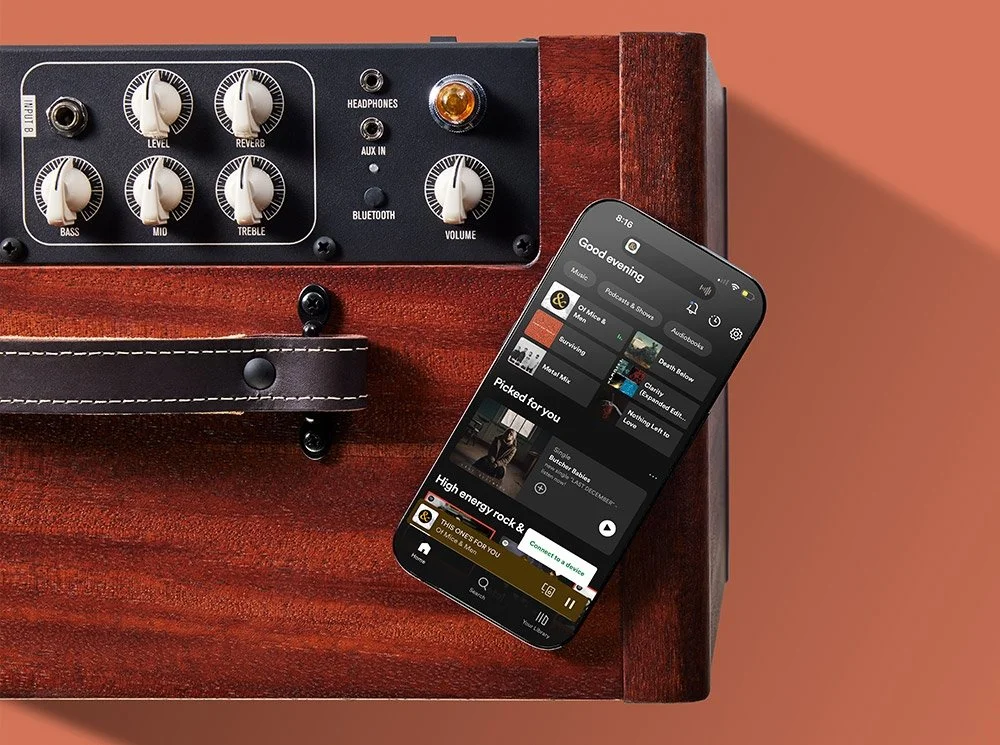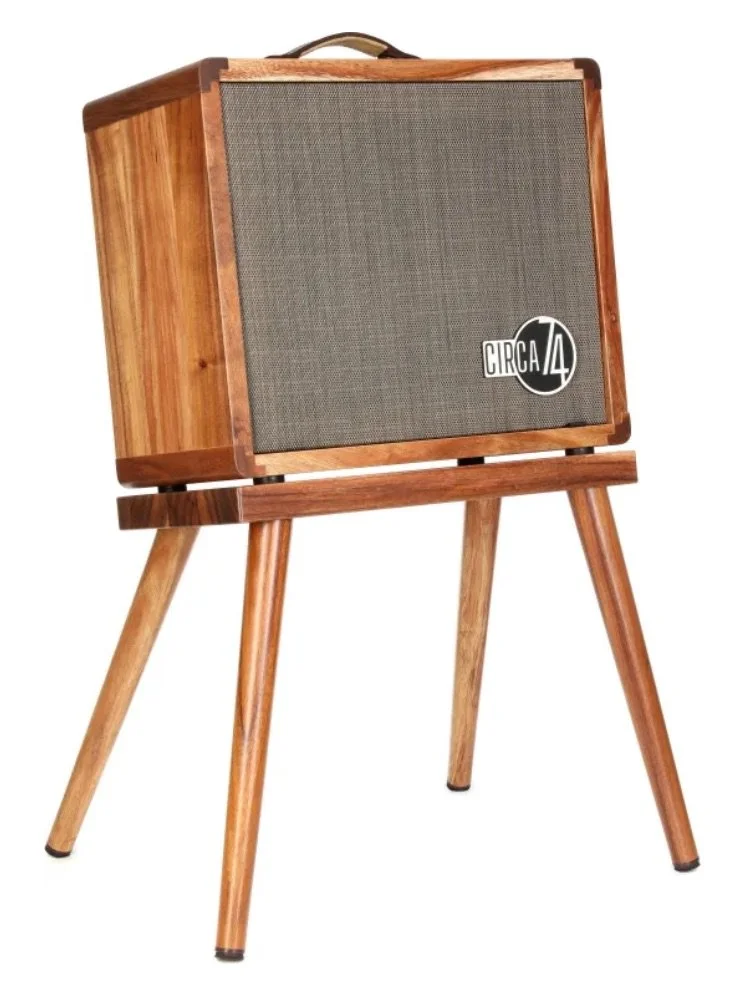Review : Taylor Circa 74 Acoustic Amplifier
The Taylor Circa 74 amplifier in mahogany. Image courtesy Taylor Guitars
It is still in this day and age surprising when a respected acoustic guitar maker gets into the acoustic amplifier business. Think of the myriad alternatives out there and there isn’t a guitar maker amongst them. Perhaps that’s about focusing on your knitting, or perhaps because no acoustic guitar maker has ever thought about what would make a superior acoustic amplifier.
This review would not be possible without the amazing support of The Arts Music Store. The Arts Music Store is a full range Taylor dealer covering all the guitar families, Circa 74 amplifiers and is one of the few qualified to offer the T5 family of electric acoustic guitars. Their on hand stock of Taylor products is amazing considering that they are not a chain store and are wholly focused on customer satisfation. When I asked about the review opportunity the only question was which model I wanted, the Mahogany or the Koa. I proposed that they pick and Colin provided the Koa version. It is really beautiful.
The Circa74
Taylor Guitar’s Circa 74 is a two channel acoustic / vocal amplifier available in two solid wood cases and includes a very 1970s support stand. It’s also a premium product, with a MAP price of $2249.99 CAD for Mahogany and $2999.99 CAD for Koa. Compare that to $1199.99 USD for Mahogany and $1799.99 USD for Koa. That is partially in thanks to the brute incompetence of the Canadian Federal government. Plus there is some other gouging happening in Canada. That’s a lot of money and not to throw water on things, no matter where you live it’s a fair bit more than other very fine acoustic amps and a lot more than the dreck that over populates the space. I also struggle with the $600 USD premium for Koa. As an amateur woodworker, I know that 4/4 Koa is more expensive than mahogany from central America but not THAT much more expensive.
Specifications
I grabbed this information right from Taylor’s USA website and to be blunt, the level of detail is completely underwhelming. We get more detail on a $200 amp from most any other builder. I am guessing that Taylor would like buyers to focus on the sound and not the specifications. I can certainly align with that, although as a gear person, I would like the option to be able to find out.
Let’s look at what the company tells us. It is a two channel amplifier, one configured primarily for low impedance vocals, the second primarily for high impedance guitars. It can push a maximum of 150 watts into a single ten inch speaker. There is an AUX in so the user can mix in audio from an external device, either for play along with or backing tracks. No indication whatsoever of how those 150 watts are delivered, and in the absence of data, and given that this is effectively a PA, I am going to speculate that it is a Class D amplifier. As there is nothing wrong with that, why not be clear?
Each channel has its own level (gain) control, three band EQ and what Taylor calls Room Reverb. As the box makes no sound when being moved, I am concluding that it is digital reverb. Nothing wrong with that either. There is also bluetooth connectivity so you can stream to the device from your mobile device.
It is surprisingly compact on viewing but not particularly lightweight due to solid wood cabinet. It does require AC power, so busking with it will be a no go unless you are also dragging along a DC to AC power supply.
Channel One has an XLR / TS input best suited for a microphone or a guitar using a low impedance converter in line, which is my preferred method. Channel Two has a TS input. The Aux in is ⅛”
Taylor has a superb reputation for its wood working capability and the cabinet and stand both shine in this regard. I personally suspect that the wood contributes to a big part of the cost. The cabinet work is excellently done, no veneers in the sides, top or bottom that I could see and the mahogany or koa depending on the version that you select are very nice figured pieces. I would expect nothing less from Taylor Guitars. Bob Taylor knows wood.
The amp is also compact whether used with or without the stand and is less obvious amongst the furnishings of the room where it is used.
Image courtesy Taylor Guitars
Controls
The controls are clear, easy to read and the knobs are large enough to be easily used by larger fingers. The layout is as simple as anyone could possibly ask for.
Simple, clean channel control set. Image courtesy Taylor Guitars
Each channel has identical control sets, not always common in two channel acoustic amplifiers. Beside channel two are the inputs for Aux and Bluetooth as well as the unit Master Volume control. There is also a headphone out jack. Having separate level controls for each channel allows the user to set his or her own mix.
Master volume, aux and bluetooth. Image courtesy Taylor Guitars
Taylor Guitar’s website also provides proposed starting positions for different acoustic guitar pickups, useful I suppose to those who have never used an acoustic amplifier before. For my samples, I will use the recommended settings where they exist.
What I did not find at all were images of the back panel of the amplifier. That could be entirely on me, so please pardon the crap image from my phone of the back plate.
Rear panel
What we can learn from the back panel is both good and bad. It has a direct out so a player can take advantage of the amplifier’s preamp section and send that direct to desk or a PA either via TS high impedance or XLR low impedance. There is also a line in TS jack.
Power is as noted AC 100-240v so no voltage converter necessary in different parts of the world. We see that the amplifier is Designed in El Cajon California but does not specify where it is actually assembled. My unit was picked up already unboxed so I have no shipping labels to refer to. I don’t actually care where it is built. People buy Apple products by the zillions and don’t care and Apple only says Designed in California. So for those with a Buy American disposition, this isn’t it. I find the price high in this regard, because if made in Asia, (I do not know for sure), I do know that labour costs are about 1/16th maximum that of American labour costs. So why the astronomic price point? I bring this up because Taylor sellers have indicated that buyers have tried the amp and like it but are not buying because of the price tag. If these amplifiers are actually made in El Cajon California or Taylor’s factory in Mexico, why not say so?
What disappoints me greatly is that there is no Phantom Power capability, negating the use of any microphone that actually needs phantom power or the use of inline impedance converters, so my hope of connecting my guitars directly to the low impedance input is dashed without putting a powered impedance converter in the circuit. I consider this a design failure given the cable length limitations and capacitance loss evident in all high impedance cables. Perhaps they will fix this in version two but if the amp has been in development since COVID as is claimed, I am astounded that Phantom Power is not present given that providing it is a zero cost option. Having to spend more money for a proper input option on an amp that would already cost me $2249 is a fail in my book. Even my unloved Fishman has this option. Of course so do both my AERs which cost substantially less than the Circa 74.
The Sound
As I could not connect my guitar using low impedance options, I chose a short Pig Hog studio grade cable. Pig Hog cables cost a bit more and in my experience are worth every penny. The first guitar that I used is my Taylor Limited Edition E14ce which is spruce over ebony sides and back. I was at a Taylor event at The Arts Music Store and the demonstrator was playing this guitar. Standing off in a corner, far from the stage, I nearly gave myself whiplash when I heard it and ran to the store owner and told him it it was his stock it was sold. Carl made it happen, as he always has and while I own many Taylor guitars, the E14ce is my go to Taylor.
Taylor’s ES-2 pickup/preamp system is in my opinion the best all around factory delivered pickup system because of the quality of its preamp, so I also played a variety of other guitars with Fishman under saddle pickups in my Alvarez baritone which performed as expected (sub optimal to my ears), the K & K pickup in my Boucher jumbo 12 string (ok but boomy), and the piezos in my Parker Fly (excellent).
The Koa verision has a more beautiful look to the wood and a darker grill cloth. Otherwise the only difference between this and the mahogany is a massive price jump. Image courtesy Taylor Guitars
Example Sounds
My setup was very simple. I ran the DI out of the amp direct to an input on the Clarett+ 8 Pre and recorded each guitar to its own track so I could try to get them similarly leveled. I also used the recommended settings for different pickups as documented by Taylor Guitars. The Taylor E14ce with the ES-2 preamp system sounds great very open and live. Moving to a 12 string Boucher jumbo with adirondack spruce over bubinga with the recommended K&K Pure Mini settings, it’s good, but would benefit if I used a preamp on the input channel. The K&K pickups are great, but in my opinion they get better with a preamp. Next I used my Alvarez 8 string baritone which has a built in Fishman under saddle pickup and alleged preamp. Acoustically this guitar is awesome but with the recommended settings for a Fishman set on the amp., it sounds tight and loses all the presence of the guitar. I will spend more time on this one because I believe that with a good input channel and different settings I could sound out of this amp that more accurately portrays the guitar. The final guitar is my Parker Fly using only the piezos in the bridge saddles. I set the volume to midway on the guitar and centred the tone. On the amp, I set all the tone knobs at noon because understandably there was no recommended setting from Taylor. There should be considering the T5z family but that is another thing entirely. The Parker Fly piezo outputs sound great but then Ken Parker did do a lot more work than stuff piezos in the saddles and then stop.
Overall, I am very impressed with this amplifier. I think that with some work, and a proper preamp if your guitar lacks one, you could make this work with any acoustic with a decent pickup. Certainly it pair matches to the Taylor ES-2 system and frankly it must do so. I tried other guitars with Fishman under saddle pickups and it still left me underwhelmed and in that kind of use case, I would advocate the less expensive and to my ear, better sounding overall, AER Compact 60. However if you are a Taylor player and like keeping things in house, and can handle the over the top pricing, you will be well served by the Circa 74.
I find that I really don’t like any acoustic pickup recorded direct to NVRAM, although an excellent preamp in the flow makes a huge difference. Thus, I did make two changes in post production. First I added a Universal Audio Precision Maximizer. It is my favourite Maximizer as it is subtle and doesn’t hit like a ton of bricks (Izotope, that’s you) and then I used my favourite mastering compressor for acoustic guitars, the Shadow Hills Mastering Compressor with a 2 stage Discrete compression setup. Images of the settings on both follow.
Wrapping Up
While there are superb dedicated acoustic guitar amplifiers already in market, such as the AER line that I recommend first, and the surprisingly good LANEY A series if you can find one, I rank the Taylor above the LANEY and everything other than the AERs. It outperforms every other acoustic amplier that I have played at some length including everything from Fender, Fishman, BOSS and even the similarly priced Mesa Boogie Rosette, not that you can find them anywhere since Gibson destroyed Mesa. I say this solely from the perspective of audio quality. Unfortunately the very high price tag takes a lot away from the saleability of these amplifiers, making them very much a niche play and vaguely boutique-ish. That may be the intent as Taylor has also released their Gold Label guitars which are also very highly priced and boutique-ish.
If you like what I do here for you, please become a supporter on Patreon. Your monthly contribution makes an enormous difference and helps me keep things going. To become a Patreon Patron, just click the link or the button below. Always feel comfortable to send in a question or to post a comment. I read them all and respond as appropriate. Thanks for your support of my work. I’m Ross Chevalier and I look forward to sharing with you again soon.









